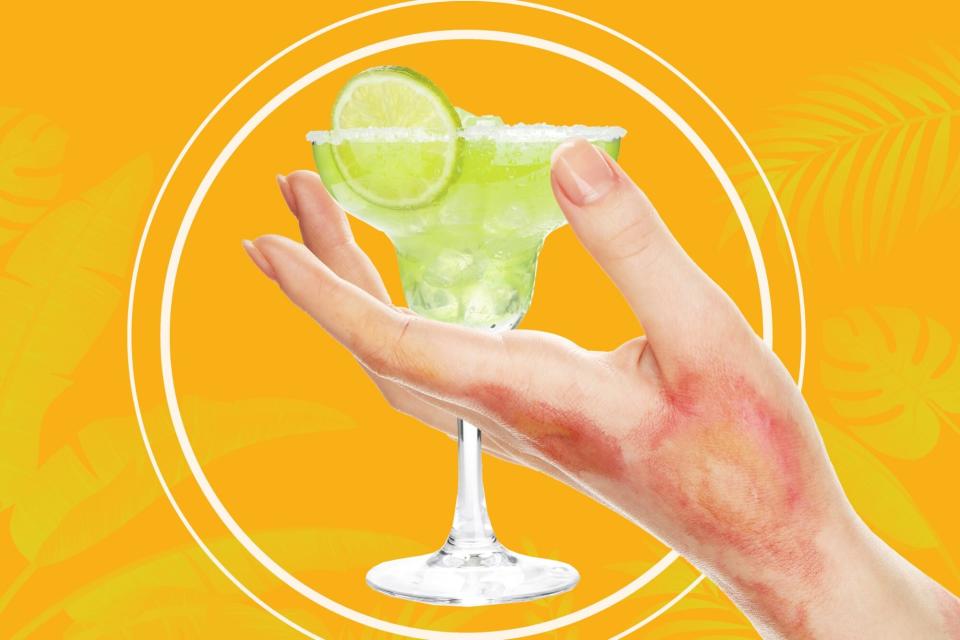What You Should Know About Margarita Burn Before Summer Starts
There's nothing like drinking a freshly-made margarita on a lounge chair outdoors to make the most of a Summer Friday — that is, however, until you start to feel a burning sensation in your hands and look down to discover your skin's red, blotchy, and blistering. Meet the margarita burn.
Also known as phytophotodermatitis, a margarita burn is a type of contact dermatitis (aka skin reaction) that occurs when your skin comes into contact with certain plants or fruits and then is exposed to sunlight. So, how did Jimmy Buffet's favorite bevy get dragged into the mix? Citrus fruits — limes, in particular — are some of the main culprits. So if you've ever juiced a bunch of fresh limes to make a pitcher of poolside margs only to end up with red, swollen blisters on your hands (although it can occur other places too) — you might've had a margarita burn. The good news: Phytophotodermatitis can be easily prevented without giving up the fan-favorite summertime beverage. Here, dermatologists explain everything you need to know about phytophotodermatitis, including the many ways it can be brought on — some of which have nothing to do with tequila.

AdobeStock
What Is Phytophotodermatitis?
Phytophotodermatitis is a type of contact dermatitis, but there's a bit of a process behind it, explains Ife J. Rodney, M.D., F.A.A.D, a board-certified dermatologist at Eternal Dermatology in Fulton, Maryland. "First, your skin has to come in contact with certain plants or fruits," she says. Citrus fruits — limes, lemons, grapefruit — are frequently responsible for margarita burn as is hogweed (a type of toxic weed that's typically found in fields, forests, and along roadsides and streams), fig, basil, parsley, and parsnip. But peeling a grapefruit or snipping some parsley isn't necessarily going to result in phytophotodermatitis. (And, no, simply eating or drinking them will not cause a skin reaction.)
In order for phytophotodermatitis to occur, a residue from these plants must be left behind on your skin and be exposed to the sun's UVA rays. This activates a chemical commonly found in plants and fruits known as furocoumarins, which can then trigger an inflammatory response topically, she explains. It's worth noting that of the plants and fruits mentioned above, parsley, grapefruit, and lime have the highest concentrations of furocoumarins, and as such have the highest likelihood of triggering more intense symptoms.
"Symptoms include, but aren't limited to, swelling, pain, redness, itchy/raised bumps, and areas of blistering," says Lucy Chen, M.D., F.A.A.D., a board-certified dermatologist at Riverchase Dermatology in Miami. Dr. Rodney adds that phytophotodermatitis can also manifest as a rash, sometimes one that's fluid-filled and even painful.
Ultimately, "the degree of response depends on how much residue is on your skin, what type of plant you were exposed to, and how long you've been exposed to the sun," she says. (Essentially, going for a quick walk with a swipe of lime on your finger from making guac is very likely not going to result in a margarita burn.) It most often shows up on the hands, arms, and legs (areas exposed while cooking, hiking, or gardening), explains Dr. Chen, who adds that it usually takes about two hours after sun exposure for these symptoms to start to show up.
How Common Is Phytophotodermatitis?
While margarita burn is a very real phenomenon, the odds of it occurring is actually fairly low. Phytophotodermatitis is one of the least common types of contact dermatitis, according to Dr. Chen. She also says that it's not that serious of a condition, though you'll likely need to see a dermatologist if you do end up with bubbling, burning skin. This is because there really is a multi-step process that needs to happen in order for the condition to develop. (Related: How to Get Rid of a Poison Ivy Rash — ASAP.)
Still, "it happens mainly during the summer since the plants that produce the most furocoumarins grow during this time of year," adds Dr. Rodney. "We're also outside a lot in the summer and can come in contact with these types of plants on hikes and while camping. Home gardeners, people who grow these plants in mass, and people who use these plants in cooking are most at risk."
How Can You Prevent Phytophotodermatitis?
In more good news, preventing phytophotodermatitis is also pretty easy. In the case of a drink-making or cooking scenario, the best thing to do is thoroughly wash your hands with soap and water immediately after handling any of the aforementioned plants. Also a good idea? Wearing gloves and/or long-sleeved shirts and pants when gardening or spending time outdoors, as well as being extra diligent about sun protection, especially if you think you've been exposed to one of those plants or fruits, adds Dr. Chen. (That said, applying sunscreen on all exposed areas before hanging in the sun is always the right idea.)
How Do You Treat Phytophotodermatitis?
If you do end up with a case of margarita burn, you'll definitely want to book an appointment with your dermatologist, says Dr. Rodney. Your doc will be able to determine if you're truly dealing with phytophotodermatitis by a simple visual exam and asking you a series of questions about past exposure to, say, grapefruit or basil and time in the sun.
Antihistamines or oral steroids may be prescribed in extreme cases of severe pain and blistering, though a prescribed topical steroid cream is the usual course of action, notes Dr. Rodney. Placing a cold washcloth on the affected area can soothe the skin temporarily and provide relief from other symptoms. But above all, "phytophotodermatitis needs time away from the sun to allow the skin to heal and recover, and this can take weeks or even months," explains Dr. Rodney. (Up next: How to Treat a Sunburn for Fast Relief)

